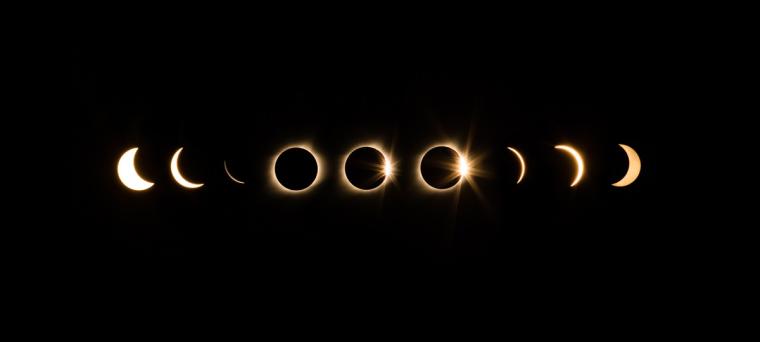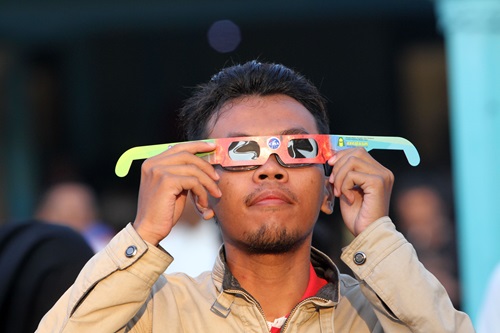
If the emails aren’t hitting your inbox like asteroids, you really need to check your Internet connection.
The biggest celestial event of the year, the total solar eclipse, is finally here. And Forbes notes it could bring the U.S. a $1 billion impact by the time the dust settles.
According to NASA, the action takes place on Monday, April 8. The eclipse will cross North America, passing over Mexico, the United States and Canada. It will begin over the South Pacific Ocean. Weather permitting (because cloudy and rainy skies tend to put a damper on such things), the first location in continental North America that will experience totality is Mexico’s Pacific coast at around 11:07 a.m. PDT.
NASA continues, “The path of the eclipse continues from Mexico, entering the United States in Texas, and traveling through Oklahoma, Arkansas, Missouri, Illinois, Kentucky, Indiana, Ohio, Pennsylvania, New York, Vermont, New Hampshire, and Maine. The eclipse will enter Canada in Southern Ontario, and continue through Quebec, New Brunswick, Prince Edward Island, and Cape Breton. The eclipse will exit continental North America on the Atlantic coast of Newfoundland, Canada, at 5:16 p.m. NDT.”
The cities expected to be in the path of totality are as follows:
- Dallas, Texas
- Idabel, Oklahoma
- Little Rock, Arkansas
- Poplar Bluff, Missouri
- Paducah, Kentucky
- Evansville, Indiana
- Cleveland, Ohio
- Erie, Pennsylvania
- Buffalo, New York
- Burlington, Vermont
- Lancaster, New Hampshire
- Caribou, Maine
All areas shown above will also experience a partial eclipse before and after these times. Cities that are not on that line may see only a partial eclipse. And, says Exploratorium, “The difference between a total solar eclipse and a partial one is literally the difference between night and day.”
Oh, and once it passes outside the borders of the USA, it still has a ways to travel, according to Agence Spatiale Canadienne (the Canadian Space Agency). In Canada, the solar eclipse's path of totality will cover the following areas:
- Hamilton, Ontario
- Belleville, Ontario
- Montreal, Quebec
- Sherbrooke, Quebec
- Fredericton, New Brunswick
- Miramichi, New Brunswick
- Alberton, Prince Edward Island
- Summerside, Prince Edward Island
- Meat Cove, Nova Scotia
- Gander, Newfoundland/Labrador
 After that, according to Eclipse2024, the phenomenon leaves land behind and goes out over the ocean. It ends with sunset over the North Atlantic.
After that, according to Eclipse2024, the phenomenon leaves land behind and goes out over the ocean. It ends with sunset over the North Atlantic.
The last time a solar eclipse crossed North America was in 2017 (which made it the first solar eclipse in the USA in 100 years), and wow, did sports destinations embrace it.
Not to be outdone, cities to be affected (and even those that will only be partially affected) in 2024 have developed a range of promotions. Here’s a quick glimpse around the USA, highlighting some of those.
There is the Beat the Eclipse 5K in Albuquerque, as well as a whole lot of others. Not that it stops anyone; a visit to Running in the USA brings up a calendar list that includes day-before races like one in Elmira, New York (Eclipse Your PR) and another in Terre Haute, Indiana (Total Eclipse of the Haute), as well as a full listing of 5Ks on Monday (probably the least popular day to do a 5K, but with names like Moon Shadow 5K and Texas Eclipse Ring of Fire Half Marathon, well, who can blame them?
Oh, and Maine has this great run, the Millinockeclipse, which starts at 2:20:53 p.m. (the same time the eclipse begins) in Millinocket. At 3:34:15 p.m. (the end of the total eclipse), all runners will turn around from wherever they you are, and head back. Whoever goes furthest wins. (Maine, in fact, has its own landing page for the eclipse; find it here.)
Erie, Pennsylvania has the “Ultimate Sun Block” promo going on, with the tagline, “Hope to see you here. Until we can’t.” The destination also has a running calendar of events on this page. Additional resources and information can be found at this link.
Lake Erie Wine Country (which is the largest grape-growing region East of the Rocky Mountains, and home to many growers for Welch’s) is hosting an event called “Lights Out!” which will include tasting at local wineries as well as eclipse viewing at a host winery. The event runs from April 5-8, 2024. The Lake Erie Speedway will host a festival on April 8 that will feature food trucks and vendors, drifting and ride-alongs as well as live music.
Camp Fitch, another Erie location, is hosting an Eclipse Camp April 7-9 that includes lodging in their cabins, a “Solar Bear” plunge in Lake Erie, and programming/camp activities that includes rock climbing, mountain bikes, archery and other activities. The camp is located right on the shores of Lake Erie as well, so eclipse viewing is expected to be excellent. And finally, Mercyhurst University was designated as a NASA “Sunspot Viewing Site” and will host events leading up to and during the eclipse on their Erie campus.
Dayton, Ohio will host three Eclipse Watch Parties at Dayton National Park. The first 300 attendees at each watch party will receive a 2024 eclipse patch. Activities vary according to location, but include broadcasts of the NASA livestream, presentations from NASA SCoPE subject matter experts, an Eclipse Junior Ranger activity, solar eclipse painting and multiple art and educational activities for children and adults. The park information tent will have free solar eclipse viewing glasses and a LightSound set up for the blind and low vision community.
In the Miami Valley of Ohio, a number of other activities will be offered; they are listed here and include everything from watch parties to viewings of the movie, 2001: A Space Odyssey.
In Indianapolis, there is a planned NASA event at the Indianapolis Motor Speedway. The White River State Park, notes the Indy Star, “ is among those going all out with more than 40 food trucks and a full weekend of events.”
Little Rock, Arkansas has a whole landing page, with concerts, activities and more, including the MiLB team, Arkansas Travelers’ event, “Total Eclipse of the Park.” (If it’s anything like the 2017 event for the Oregon Salem-Keizer Volcanoes, fans and players on the fields were issued team-logo eclipse safety glasses. The game was expected to be stopped for the 15 minutes or so the light would be affected, after which, play resumed.) Heads in beds are, of course, always desirable, but so are butts in seats at sports events.
Also in Arkansas, the Magic Springs Theme and Water Park will host a day-long festival and celebration.
In Dallas, a special landing page has a countdown, a video detailing places to see the eclipse and a calendar of events at sites including the Perot Museum of Nature and Science, Dallas Arboretum and Botanical Garden, Downtown Dallas Inc. at Klyde Warren Park, Frontiers of Flight Museum, Marriott Dallas Downtown and Samuell Farm. There are also links to help visitors find accommodations.
Visit Butler County, MO (where Poplar Bluff is) likewise has a dedicated landing page for the event. Oh, and Cleveland, hats off to you for this great car racing game to try to beat the eclipse.
In the Adirondacks, the Regional Office of Sustainable Tourism has a special web page, ECLIPSEADK, with listings of activities according to various locations. These range from festivals to late season skiing to giveaways of branded eclipse glasses. In fact, New York has events throughout the state.
The Dallas/Fort Worth area is taking the whole souvenir thing one step further, minting a commemorative silver coin; these are being sold for $49.99 each.
What’s that? The eclipse is throwing shade at your destination by overlooking it? All is not lost. This year will also bring multiple meteor showers, a close call with a comet and even a partial lunar eclipse.
And according to NASA, after this year, the next total solar eclipse that can be seen from the contiguous U.S. will be on August 23, 2044. That’s right: 20 years from now. However, another total solar eclipse will occur in August 2026 – but you’ll need to be willing to travel to see it, as it will only be seen in Russia, Greenland and Europe. In Europe, the path of totality will cross over Iceland, Spain and Portugal.
Stateside, there will be a corresponding partial solar eclipse in all or parts of Alaska, Connecticut, Delaware, Iowa, Illinois, Indiana, Massachusetts, Maryland, Maine, Michigan, Minnesota, Montana, North Carolina, North Dakota, New Hampshire, New Jersey, New York, Ohio, Pennsylvania, Rhode Island, South Dakota, Virginia, Vermont, Wisconsin and West Virginia. Expect more information from NASA as this event nears.

